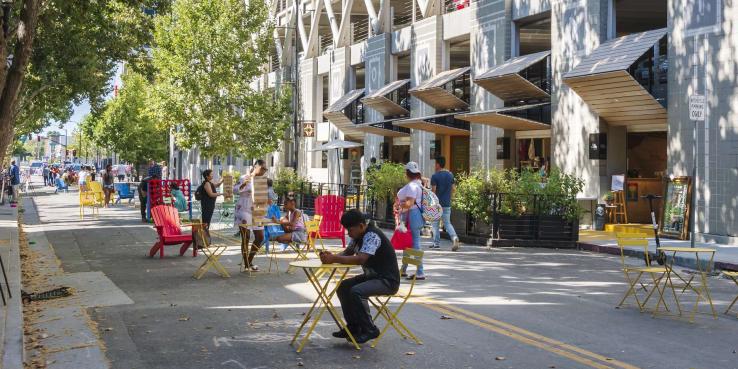For San José, 2019 was a year of planning for the big ideas launched in 2018. The city made major progress on the policy analysis, planning processes and community dialogue needed to realize those visions, with some notable milestones.
Diridon Station: The expansion of Diridon Station has been a major priority for SPUR over the past few years, and in 2019 we continued our efforts to develop a seamless transit hub in central San Jose. At the end of the year, the transit agencies partnering on the expansion completed a momentous step, producing a unified rail alignment and conceptual station design. SPUR strongly supports the proposed layout, which reflects our advocacy to design the station with the user at the forefront. Maximizing ridership will require building enough capacity for future population growth, as well as providing easy access for riders. We think the partners are doing a great job in multi-agency planning; it’s not easy or fast, but it’s necessary if we are going to get seamless integrated transit in the region.
Caltrain: After two years of planning, the rail agency adopted a new business plan to achieve a high-growth service strategy. This work follows SPUR’s collaborative effort to look at how to expand this vital service. We continue to encourage the agency to think bigger about its future, given the critical role it plays in connecting people throughout Silicon Valley.
Google transit village: Google’s planned development near Diridon, now dubbed “Downtown West,” will expand the downtown core of San Jose, something SPUR has long encouraged. We are excited by the rising design quality of the office buildings, consistent with our Rethinking the Corporate Campus work. Part of that story is a rising skyline: In January, the city council approved a proposal to increase building heights downtown and around Diridon, a recommendation made by a cross-sector committee including SPUR. Taller buildings will allow more development capacity, generate more transit riders and increase revenue from development fees to support more affordable housing and investments in public space.
Housing: As a follow-up to our 2017 report Room for More, we published It Takes a Village, a white paper that highlights the challenges San Jose has faced in implementing its mixed-use urban village strategy and how to improve the delivery of housing in those areas. This paper has informed the discussions of the Envision San Jose 2040 General Plan four-year review, which I am co-chairing.
Guadalupe River Park: Our collaborative efforts to elevate the river park as a great central green space in the city’s urbanizing core have continued through research and planning. In the spring, we published a white paper on the river park. We’ve since launched two research projects that will explore the opportunities and barriers for a future design that supports and enhances a flourishing natural habitat; connects downtown to the surrounding neighborhoods; serves as a catalyst for economic and cultural vitality; and, provides an inclusive gathering place for residents, workers and visitors.
Green building: In 2018, San Jose was selected by Bloomberg Philanthropies as a winner in its first American Cities Climate Challenge. As part of the challenge, San Jose recently adopted a "reach code” ordinance, a local building energy code that “reaches” beyond the state minimum requirements, creating a model for other cities. SPUR served on a stakeholder task force and supported the ordinance, which upholds many of the principles laid out in our 2016 report Fossil-Free Bay Area.
Coyote Valley: After decades of debate over the future of North Coyote Valley, the San Jose City Council voted to purchase more than 900 acres of undeveloped land and preserve it as public green space. SPUR endorsed 2018’s Measure T which earmarked up to $50 million for land conservation acquisitions in Coyote Valley. We support the city’s new vision for Coyote Valley, one that proactively addresses climate change and resiliency through open space preservation.
SPUR Impact Awards: We held our first SPUR Impact Awards in March, acknowledging outstanding impact by public sector employees in city and county government in Santa Clara County. The inaugural event was a tremendous success and highlighted the people and projects making a difference in local government. We will soon announce our 2020 honorees, and we look forward to our award luncheon on Friday, March 20, 2020.
Public life activation: This year, we partnered with WeWork on its project to transform a portion of Fountain Alley and the adjacent parking lot into a temporary public plaza, complete with a stage, co-working space, shopping, games and a pop-up bar. To help introduce public life to this new public space, SPUR curated a weekly speaker series that highlighted the people and organizations playing a critical role in shaping community engagement, civic pride and urbanism locally and nationally.
Downtown design guidelines: This year, San Jose approved new Downtown Design Guidelines and Standards, replacing the outdated 2004 guidelines and providing clear direction on all aspects of building design downtown. SPUR firmly supported the update and was highly engaged in the update process, hosting feedback sessions on the draft guidelines with members of the design and architecture community, as well as the public.
These steps are the building blocks for the future San Jose is collectively shaping. We look forward to helping advance these and other ideas in 2020.
